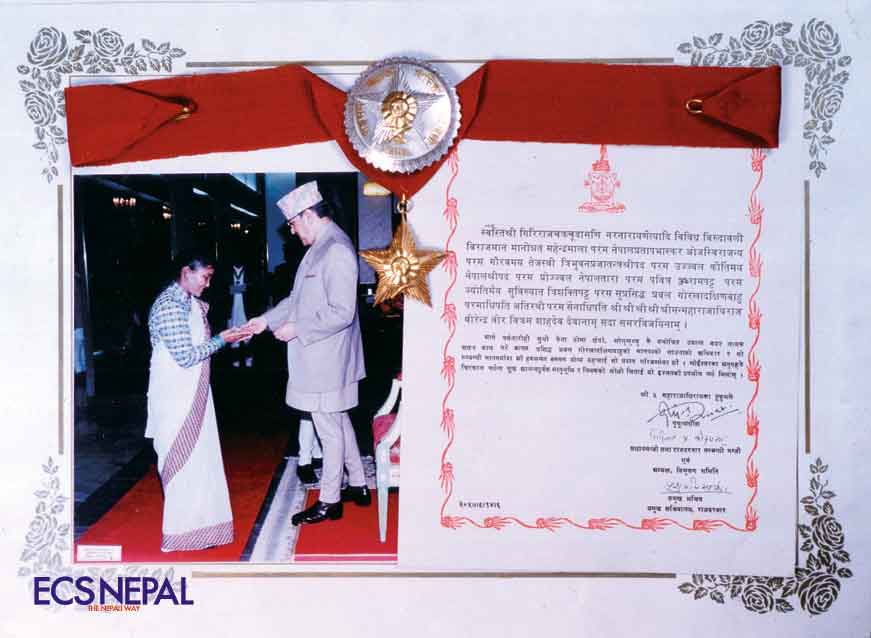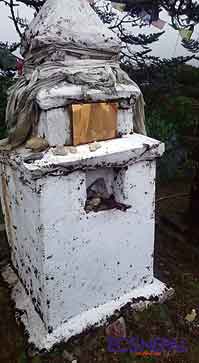Although, today, Everest has been summited by thousands, including a good number of women, the pioneering feats of the few that showed the way cannot be forgotten.
The 1970s saw a rapid increased in the number of expeditions traveling through Namche
Bazaar, on their way to Everest and the high Himalaya. As the yaks with their heavy loads stumbled up the steps and through the tiny streets, accompanied by foreign expedition members wearing their brightly colored clothes, often covered with badges, a little girl would watch with increased interest from her front door.
By 1987, that same little girl had completed her education at the Hillary School in Khumjung, and was ready to launch herself into the wider world. By chance, she had the opportunity to visit Europe, where she continued her informal education, learning several languages, besides undertaking a computer science course.

Over the next few years, Pemba Dolma Sherpa continued to travel back and forth to Europe, where she earned money from selling Nepalese souvenirs and other products. She never lost her love for the mountains, and took the opportunity to develop her mountaineering skills and ascend many of the alpine peaks. When she was back in Nepal, and specifically, back at home in Namche, she continued with her mountaineering activities, with ascents of Mera Peak, Lobuche East,and Island Peak.
As time went by, Pemba was beginning to develop a desire to climb an 8,000 m peak, and prove that all the stereotype perceptions of the Nepali people, and the Sherpani in particular, were not true, and that they were just as capable of organising and achieving 8,000 meters as any male—Nepali, or not. Over the next ten years, she lived frugally, saving everything she possibly could in preparation for achieving her dream, although as yet she had no specific plans.
In 1999, Kari Kobler, who was planning a Swiss expedition to Everest from Tibet, happened to be staying at Pemba’s family lodge in Namche

Bazaar. During the course of conversation, it was mentioned that there were three Swiss women on the expedition, and one woman from New Zealand. Pemba was drawn more and more to the idea of setting her sights on Everest, when eventually, she had a conversation that she perceived to be a virtual invitation to join the team. As she had no sponsorship or financial support, she set about working as many hours as she could to save enough money to purchase her own equipment and pay for a place as a member of the Swiss 2000 Everest Expedition.
Arriving after the main contingent of Sherpas and climbing members had left the base camp, Pemba set off on her own. Each evening she arrived at the next camp, most were unmanned, and she would complete the solitary rituals of melting snow, making food, and preparing for the night ahead, before climbing into her sleeping bag. “Even with the sounds of a big mountain, and despite being alone in the camp every night, I was never frightened,” said Pemba, “I had spoken with Sagarmatha, and felt that she had understood my situation.”The weather was good, and using the fixed ropes and oxygen from Camp 3, she slowly gained height; on the final day, she left with all but a few sweets and her camera, from the top camp. Climbing alone, she reached the summit at 9:00 a.m. (China time) on May 19, 2000, thus becoming the first Sherpani to reach the summit of Everest from the Tibetan side.

Pertemba Sherpa, who was in the team that made the second ascent of the SW Face route on Everest in 1975 as part of the first ascent expedition, was also in the Tibet base camp at the time of Pemba’s first attempt, he was the base camp manager for the Japanese team. The Swiss expedition was a fairly low budget affair, and Pertemba can recall Pemba making many journeys up and down, stocking higher camps, as there were only a few mountain workers allocated to do this work. Noticing that Pemba appeared to lack essential supplies, he arranged for his expedition staff to provide these items through his Nepali climbers higher up the mountain. These supplies had Pemba’s name marked on them, and they were placed in her tent.
Towards the end of 2001, she applied for a solo permit to ascend Everest from the Nepali side. Nima Nuru, her brother, runs his own trekking company, Cho Oyu Trekking, which was at that time supporting an Italian Everest expedition; he provided Pemba with a kitchen and base camp crew. One of the Sherpas employed by Cho Oyu Trekking on the Italian expedition was a young andrelatively inexperienced Himalaya climber, who during the planning for the Italian summit bid, was left out of the final team selection. Pemba came across him above the advance base camp, and she quickly offered him a chance to reach the summit as her climbing partner. The summit of Everest on a Sherpa’s CV would enhance his future career prospects enormously. Climbing together, the pair reached the South Col on May 14, but the weather was deteriorating as they settled into their camp routine. The planned summit day of the 15th dawned to the sound of continued bad weather, so the pair spent another day sitting out the storm at the South Col, before finally setting out at around 9:00 p.m., and reaching the summit on May 16, 2002, at 8.45a.m. (Nepal time).

After the birth of her daughter Lhemi, Pemba started climbing again, and on September 28, 2005, she climbed Cho Oyu, reaching the summit with four clients, as leader of a seven-member Cho Oyu ‘Climb High Expedition’, a company she had established with her husband, Rajen Thapa. Pemba continued in the roles of a mother, a wife, a businesswoman, and founder of a charity, using her proficiency in nine languages to promote Nepal and her charity work, but despite leading such a full life, she yearned to be back in the high mountains.
On May 22, 2007, at the age of 37, Pemba became the first Asian woman to climb Lhotse. Pertemba was again at Everest Base Camp as the base camp manager for the Chilean Lhotse Expedition in 2007. Pemba and Pertemba met on several occasions in and around the base camp. Pertemba recalls that she did not ask for any assistance, and basically got on with her own thing. She left the base camp two days before the Sherpas, who were fixing ropes for the Chilean expedition, but up to that point, they had only fixed ropes to the lower Lhotse couloir. The couloir is approximately 600 meters of mostly 50° - 60° snow/ice, and varies in width, opening out onto the snow slopes below. Despite the fixed ropes ending approximately 200 m short of the summit, Pemba and her Sherpa companion continued upward. With great pride, she unfurled the Nepali flag, and then made preparations to return to Camp 3 below. She had only just begun the descent, when she slipped and fell over 1,000m down the great couloir.
Pertemba remembers that the weather on the day was good, although there were clouds about. His Chilean team had a late start, around 10.30a.m., leaving Camp 3 and heading up to Camp 4, when news came through that Pemba was missing. The Chilean team reported that they saw what they thought was a body in the snow just below the top of the fixed line, which at that time just reached into the gully (as far as it had been fixed). Pertemba recalls two Chilean climbers, plus two or three Sherpas, going up the fixed ropes to investigate the ‘body’, and reporting that it was Pemba. Pertemba then sent his staff, along with the expedition doctor, from lower down the mountain to go up to recover the body. The doctor pronounced Pemba dead at the scene, at which point, arrangements were made to recover the body and take her down to the base camp, from where she was further evacuated to Tengboche. She was given a full ceremonial funeral at Tengboche Monastery, the first for any woman.

Pemba Dolma was highly respected in Nepal, where she was awarded both the Suprabal Prashiddha Gorkha Dakshin Bahu (national award of Nepal) by late King Birendra Bir Bikram Shah Dev, and the Gold Medal for Mountaineering, Nepal, by former King Gyanendra Bir Bikram Shah Dev. In Italy, she was also awarded both the Sky Walk – The Soles of Records, and the Saint Vincent Award, for her contribution to mountaineering and her social work.
Pemba Dolma’s legacy can be clearly seen today, ten years later, in the way other Nepali woman have been inspired by her achievements, and who have also left their marks on Nepal’s mountaineering history.











